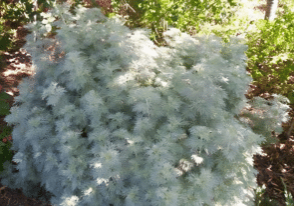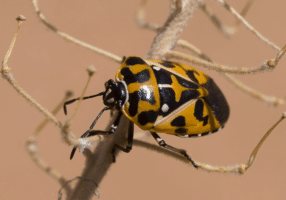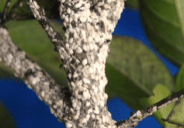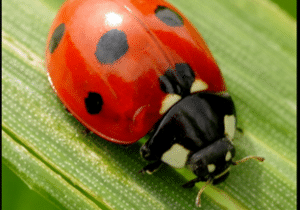By Jesse Pulliam
If you’ve noticed trace amounts of webbing in the leaves of your plants before, you may have wondered what sort of insect would have the audacity to leave its silky vestiges behind for someone else to clean up. It may have been some type of jumping spider, which commonly employs their webs as a lifeline before a jump; perhaps a leaf-curling spider (Phonognatha graeffei) has been making its home on your plants, or maybe your garden has been visited by webworms (Hyphantria cunea). Each of these answers may prove correct, depending on where in the world you live, but a possible culprit on almost every continent are spider mites.
Spider mites are minuscule arachnids that congregate on a huge variety of plants, including (but not limited to) fruit and vegetable plants, ornamentals, bushes, shrubs, trees, crops, and even indoor plants. If left unchecked, they are known to sometimes cause significant damage to vegetation, which they do by piercing plant cells directly with their needle-like jaws, and siphoning out the chlorophyll. Chlorophyll is what gives many plants and algae their green hue, which is why plants that are infested with spider mites can begin to discolor, in addition to wilting as vital nutrients are extracted.
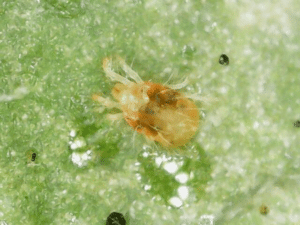
A two-spotted spider mite, one of the many varieties of color you might see.
Despite being considered pests, they do have a role to play in an ecosystem, though it is fair to
say they won’t do much to help your garden grow that couldn’t be done by something less
invasive. They do participate in nutrient cycling, as they break down organic material, and
release nutrients back into the soil. Moreover, they are a food source for useful insects, such as
ladybugs, hoverflies, and lacewings. Fortunately, spider mites are more of a nuisance than a
threat to the average person. The most you could probably worry about is them causing you a
minor allergic reaction, and then chewing on your favorite begonias until they wither. However,
they are potentially a bigger issue to farmers, as they can severely damage crops if left to their
own devices; and being toilsome to keep in check makes them a regular aggravation for people
in agriculture and horticulture everywhere.
The Challenges of Management
So, what makes spider mites so notoriously difficult to control? Firstly, they are incredibly good at evading notice, so it may take a long stretch of time before someone realizes there is an infestation at all. Not only are they extremely small–usually less than a millimeter in length–but they also tend to feed on the underside of leaves where they are less likely to be seen. While some of them do come in colors that are easier to spot against greenery, like bright red or yellow, many species are brown or green, making it nearly impossible to spot them with the naked eye. Secondly, spider mites reproduce at an exceptionally quick rate, especially under favorable conditions. A female can lay several eggs per day, and the larvae can hatch and reach full adulthood in as little as a week, at which point the cycle repeats. Thirdly, much like many species of spiders, beetles, and caterpillars, spider mites also utilize the well-known behavior called ballooning or kiting. In a similar manner to how seeds and spores can travel to new environments by catching a breeze, insects with spinnerets can release trails of silk, which can carry them on the wind for hundreds of miles. Many sailors have reported spiders landing on their ship’s sails over a thousand miles from the nearest land. Using this remarkable method of transportation, and their rapid method of reproduction, spider mites can be spread rapidly across regions. And while they tend to prefer warmer areas, some species of these mites–like the spruce spider mite (Oligonychus ununguis)–remain active in temperatures as low as 50ºF (10ºC). With well over 1,200 different species of spider mites, there less susceptible. Plantlife that has tough or hairy leaves, plants that have strong odors, and plants that produce sticky sap or resin are at a much lower risk of attracting spider mites, but it is important to bear in mind that even they are not immune.
The Signs of Infestation
As mentioned above, spider mites can be extremely hard to detect, given their ability to blend in. It is often easier to look for signs of spider mites than the mites themselves. Some indicators you might be able to see are:
- Thin webbing: Spider mites leave webbing on the undersides of leaves, which can give the leaves themselves a dusty appearance. These webbings are for the spider mites’ protection but may give them away to the keen observer.
- Stippling and yellowing: As discussed previously, spider mites pierce plant cells and siphon out the chlorophyll. This causes stippling, which appears as tiny, lightly-colored specks on the leaves. If feeding persists, the leaves will begin to discolor entirely.
- Leaf curling: Severe spider mite infestations can cause plant leaves to curl or distort, which is an obvious indicator of stress.
- Visible mites: In some cases, especially in a severe infestation, you may be able to see the mites themselves. To inspect for their presence, you can gently shake a leaf over a piece of white paper, and examine the paper for tiny, moving dots. A magnifying glass may make this process easier.
The Best Defense
As you now know, dealing with spider mites can be challenging, but there are many effective
methods you can use to keep them from taking over your garden.
- Spraying with water: As simple as it may sound, a strong jet of water can easily dislodge mites from plants. Regularly spraying down affected foliage can greatly reduce mite populations, especially if done early on in the infestation.
- Pruning: If the mites are localized to a single area, pruning and removing infested leaves, and disposing of them properly will prevent the spider mites from spreading further.
- Insecticidal soap: Insecticidal soaps can suffocate mites, making them a potentially effective treatment option.
- Predators: There are many insects you can introduce into your garden that will go on the attack for you, which will keep the spider mites in check. Such predators are ladybugs, lacewings, hoverflies, predatory mites (Phytoseiulus persimilis, Amblyseius andersoni, Neoseiulus californicus), stethorus beetles, rhyzobius beetles, and minute pirate bugs are all effective predators of spider mites.
- Miticides: In severe cases, a miticide may be necessary. These are products that are formulated specifically to target mites, and should be used carefully.
- Isolation and quarantine: If a particular plant is infested with spider mites, isolating it from the other members of your garden can prevent them from spreading. Additionally, quarantining new plants to ensure they’re parasite-free before adding them to your garden can help stop a mass infestation.
In conclusion, spider mites are formidable pests that can wreak havoc on a wide variety of plants. Their ability to reproduce rapidly, evade detection, and disperse over long distances makes them a challenging adversary for gardeners, and farmers alike. While they play a role in natural ecosystems, their potential to cause damage means they are often viewed as a nuisance. Managing spider mite infestations requires vigilance, early detection, and proper treatment to protect plants from harm.

